| |
Or, "Where It All Began." 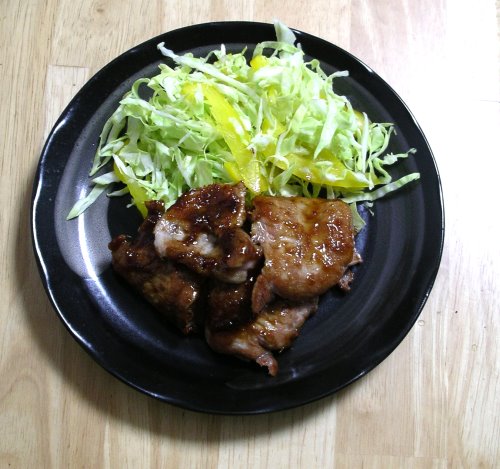 This is shouga-yaki, or ginger-glazed pan-fried pork. It was the first dish Matthew made out of his brand-new Japanese cookbook, and later, the first dish he made for me when I arrived in Kitakami. It's probably our favorite dinner, very quick, easy, and delicious — perfect on a night when we both had to work and still have some bedtime aftershocks to look forward to.
At a famous senbei (cracker/cookie) shop in Esashi, crackers are made by hand — one at a time. You need a reservation a week in advance to buy the popular varieties from this shop. 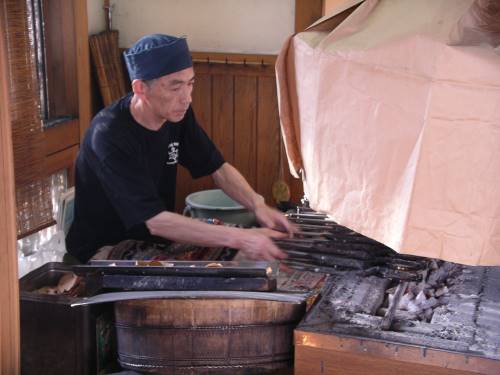
The Great Butter Shortage of '08
Saturday, May 17, 2008, 1:19 AM General, FoodPosted by stefanie Rice shortages have been in the news over the last month or so as rice-exporting countries have begun withholding supplies to feed their own people. The shortages don't appear to be affecting Japan, but the country is running low on something important: butter. For the last three weeks or so, finding butter in the stores has been hit or miss, but mostly miss. The stores kindly post signs apologizing for the lack of butter, which is cold comfort when you're contemplating dry toast for breakfast. Japan isn't generally perceived as being a dairy-centric country, so the butter deficit seems kind of surprising. To be sure, there are Japanese dairies and the Japanese do eat things like yogurt, cheese, and, ice cream. But dairy products aren't a staple in the Japanese diet like they are in the American diet, even as bread (and consequently butter) consumption has increased. None of the other dairy products appear to be in low supply (although I did notice a dearth of imported cheese today), either. Just butter. I did find a decent supply of butter in the second store I visited today, but refrained from frantically purchasing all of it.
[ 3 comments ] permalink
I made negitoro don for dinner the other night. Negitoro don is a donburi, meaning a rice bowl. It's made by topping the rice with julienned omelet, chopped raw tuna, sliced green onions, and strips of nori. 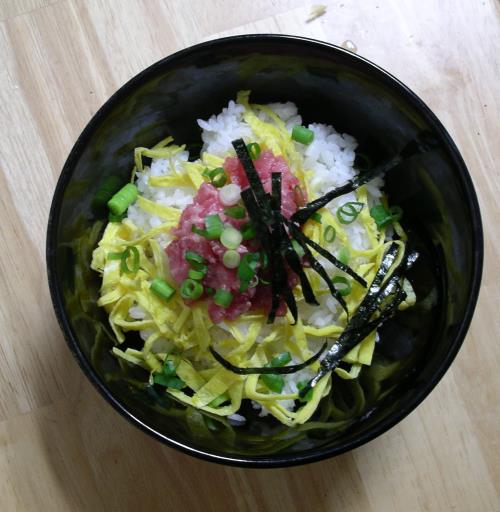 It's not a spring specialty per se, but the colors are very beautiful and springlike.
When Good Pickle Beds Go Bad
Friday, April 18, 2008, 7:07 PM FoodPosted by stefanie Oh, the horror. We've discovered the worst-tasting thing in Japan: pickles from a nuka-zuke bed that's gone off. As we mentioned in the April Fool's Day post, life around Let's Sharing HQ has gotten quite hectic. I haven't had as much time to attend to the house as I did before, so certain things have gotten neglected. Among them was the pickle bed. According to (in my opinion) the best English-language Japanese cookbook, nuka-zuke beds should be turned every day to prevent harmful bacteria from developing. Also, if the bed goes off, you should be able to tell because the bed will smell sour. My pickle bed didn't get turned for a couple of days, but when I got back to it, it smelled like it always had. It did have a thin layer of white funk on top, which I scraped off before turning the bed. I put in some daikon and let them ferment for a day or so, like usual, and they came out shrunken and softer, like usual. Then I tried to serve them. What daikon pickles should taste like: still radishy, but earthy and a little salty. What daikon pickles should not taste like: radishy spoiled milk. *sigh* Five months of cultivation down the drain.
Living in Kitakami places us smack in the middle of sansai ryouri country. As its name translates, sansai ryouri is cooking based on mountain herbs and vegetables. Yesterday, the local model shop owner's wife gave us a bunch of gyojaninniku, a type of mountain garlic or chive, along with instructions for preparing it. It's apparently pretty rare outside of Hokkaido, although the bunch she gave us was from Aomori. We did as she'd instructed, chopping the gyojaninniku finely and steeping it in soy sauce before mixing it with hot rice. We also threw in some minced shiitake (and thank goodness for the easy access to cheap, fresh, delicious shiitake), and Matthew added some nattou. 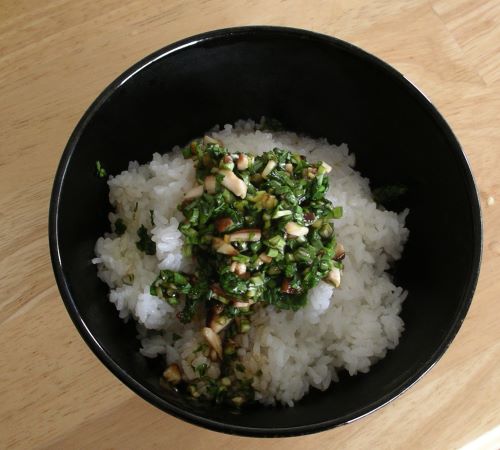 I don't know whether this technically counts as sansai ryouri, but it was really honking good.
Convenience stores equal convenience food. Hence, grilled-ham-on-a-stick: 
Because we eat rice for breakfast most mornings, we like some variety in our toppings. Matthew usually eats some combination of nattou, soy sauce, and aonori (finely ground seaweed that comes in a shaker), maybe with an egg, while I have umeboshi or milk and honey. Now, thanks to one of his students, we have a brand new bag: 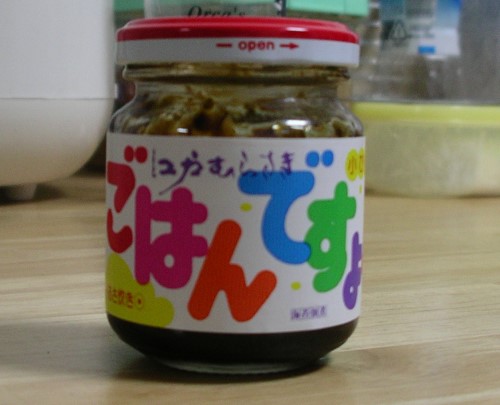 It's Gohan Desu Yo!, literally "It's Cooked Rice!" Gohan Desu Yo! is a seaweed-based condiment, lightly sweetened and flavored with small amounts of fruit and other stuff. You scoop it out of the jar with your chopsticks and mix little bits of it in with your rice for a nice, savory, seaweedy flavor. It's pretty addictive; I was actually glad to get off my milk-and-honey kick so that I could eat it. It's also a lot of fun to go around saying Gohan Desu Yo!We both already wear glasses, so we don't need to worry about this happening.
Friday, March 7, 2008, 12:46 PM FoodPosted by stefanie Last night, I made kitsune udon for dinner. 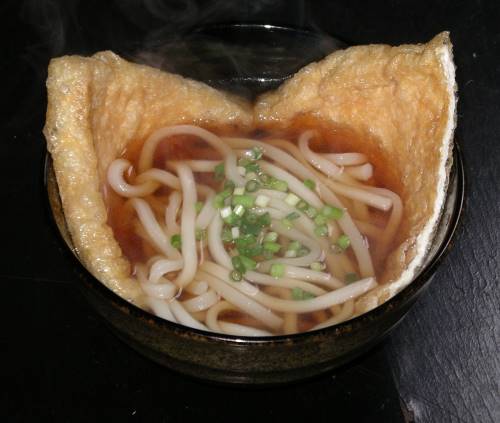 Kitsune Kitsune is the Japanese word for "fox." Legend has it that foxes love aburaage, or deep-fried sheets of tofu, hence the name. I think it's because the triangles of aburaage look like fox ears in the bowl. That's tofu-ya aburaage, by the way. Doesn't it look amazing?
Yaki = Grilled = Food... Right?
At Inukko Matsuri, we decided to enjoy some of the festival food for dinner. But what to have? Pretty much every food item available was something yaki - grilled or fried. There was takoyaki (octopus in fried balls of batter), yakiniku (grilled beef skewers), okonomiyaki (fried pancake with toppings), ikayaki (grilled squid), yakizakana (grilled fish), yakisoba (fried noodles) with or without medamayaki (fried egg), yakimochi (grilled mochi), yakitori (grilled chicken skewers), and yakidango (grilled rice flour balls). Other foods such as nabeyaki udon (fried noodle hot-pot), sukiyaki (simmered morsels), teriyaki (meat or chicken with a sweet sauce) and yakiimo (grilled sweet potato) were not represented at the festival. As we considered our options, we saw a tent set off from the others a little ways, advertising dondoyaki. What kind of food might that be? We'd never heard of it, but thought it would be best to check it out before deciding what to eat. As we approached the tent, it became apparent that food was not involved. They actually seemed to be collecting pine branches. Then it dawned on us that yaki isn't just for food - it also means burning things. In fact, they were collecting new year's decorations to burn in a bonfire as part of a Shinto ceremony. 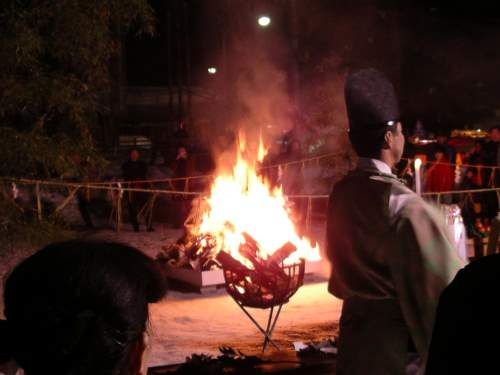 Needless to say, we opted for some of the other yakis for dinner.
Back Next
|
|









 Calendar
Calendar




